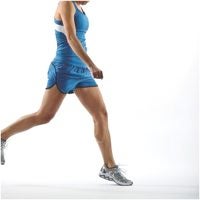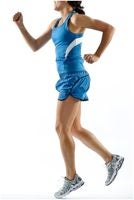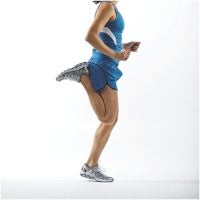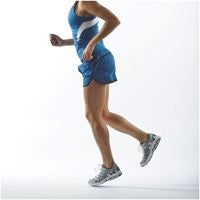New perk! Get after it with local recommendations just for you. Discover nearby events, routes out your door, and hidden gems when you sign up for the Local Running Drop.
There’s no such thing as perfect running form, but every triathlete can and should work regularly on improving his or her running technique. Why? Because it will make you faster, boost your running economy (the ability to run at a relatively low energy cost) and reduce your injury risk.
Written by: Brian Metzler
Photos by: Nils Nilsen
One of the most effective ways to improve your running technique is through form drills that accentuate specific aspects of good form and train your body to repeat those specific movements while you are running, according to Boulder-based triathlon coach and running form guru Bobby McGee.
“By being able to critically evaluate your own mechanics and then being able to habituate effective alterations through form drills,” McGee says, “you will solve a large piece of the puzzle that is great running in triathlon.”
Most drills take one or more aspects of good form—a compact arm swing, soft level footstrikes under your center of mass, quick leg turnover, an upright posture with a slight forward lean at the ankles—and accentuate them through repetitive motion that trains the body to be comfortable with that movement when inserted into your typical running mechanics.
 Taking an extra five to 15 minutes several times a week to do the five form drills detailed here can help you become more fluid, more efficient and faster for both short and long distances. That’s a pretty good return on your investment, one you’ll appreciate most in the last half of a race when you’re suffering from all-encompassing fatigue.
Taking an extra five to 15 minutes several times a week to do the five form drills detailed here can help you become more fluid, more efficient and faster for both short and long distances. That’s a pretty good return on your investment, one you’ll appreciate most in the last half of a race when you’re suffering from all-encompassing fatigue.
1) Ankling
Why: This drill teaches correct footstrike mechanics and increases stride rate.
How: Using a quick and very short stride, strike the ground at the forefoot and fold the foot down to the surface from toe to heel, with the heel reclining to the ground momentarily before popping up to start a new stride. Take small steps with minimal knee lift and minimal time spent on the ground, as if the surface below you is very hot.
Why: Ankle springs improve footstrike mechanics and create a bouncier stride.
How: Using a short stride, jog forward with a lightly bouncy movement that emphasizes landing near the ball of the foot with a level footstrike. Make sure you’re leaning forward slightly from the ankles and that your feet are striking the ground underneath your center of mass. Your short steps should create a light springing effect, not a forceful pushing sensation, and that momentum will carry you forward.
 3) Arm Pull-Backs
3) Arm Pull-Backs
Why: Arm pull-backs develop a compact arm swing and help create the tempo and rhythm of a high running cadence.
How: With a level head, level shoulders and a straight and slightly forward-leaning posture, jog forward while alternately pushing your arms backward as they are held at 90 degrees (or less). Concentrate on pulling your upper arm backward by contracting the muscles around the shoulder blades. Keep your arms swinging in a plane parallel to your torso and do not rotate your body to assist the movement.
 4) High Knees
4) High Knees
Why: This drill teaches powerful and efficient forward leg drive and a bouncier footstrike.
How: With a slight forward lean from the ankles, alternate pushing off the ground with one leg and thrusting the knee of the other leg upward and forward until your lifted thigh is parallel to the ground. Be sure to focus on soft, flat footstrikes near the ball of your foot while using your core to lower your leg down slowly instead of letting it crash to the ground.
 5) Butt Kicks
5) Butt Kicks
Why: Butt kicks accentuate the recovery portion of the running gait phase and improve leg turnover cadence.
How: Run in place with your thighs more or less locked in a neutral position and try to kick yourself in the glute with your heel on each stride. If you’re not making contact, you need to improve your dynamic range of motion.
Brian Metzler is a running coach, age-group triathlete and senior editor at Running Times.
#CelebrateTheRun in honor of National Running Day Wednesday, June 3.
Find more on the TriRock and Nation’s Triathlon sites.
